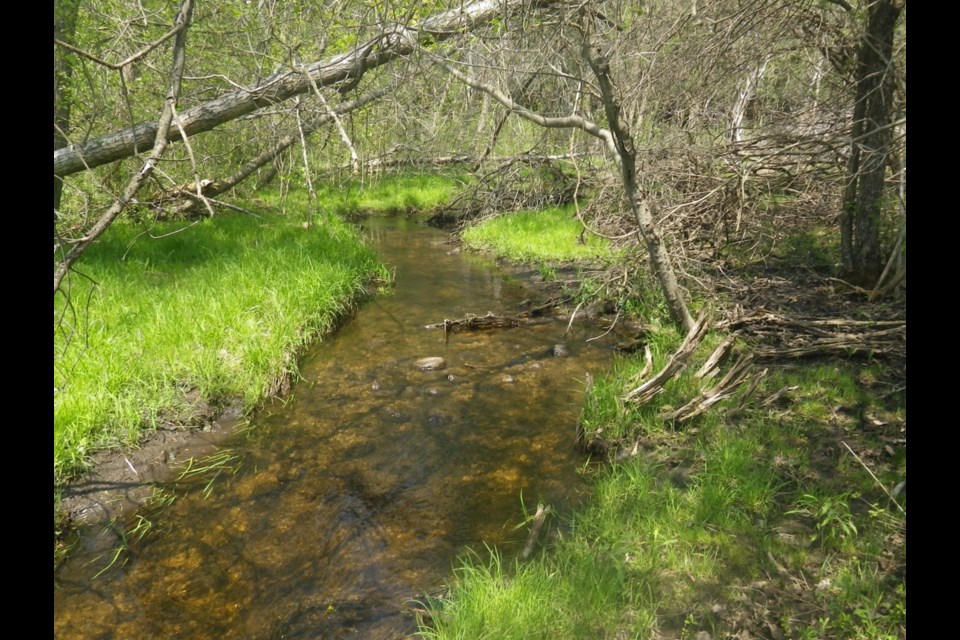Six University of Guelph students in Canada’s only biodiversity major are using everything from bake sales and crowd funding to leading-edge identification technology, to try to conserve brook trout populations and other plant and animal wildlife in and along Hanlon Creek.
The students – Eric Heisey, Hannah Little, Joschka McLeod, Kathleen Nolan, Benjamin Ranger and Giordana Scodellaro, along with their instructor Prof. Robert Hanner – are teaming up with the Speed Valley Chapter of Trout Unlimited Canada (TUC) to help further the group’s conservation efforts in the Hanlon Creek area, as part of TUC’s Reconnect Canada campaign.
The local chapter has committed several volunteer workdays to Hanlon Creek, to improve the brook trout habitat. Now, it wants to remove a weir that is preventing the brook trout from moving upstream to the headwaters of Hanlon Creek where they may be spawning.
The organization’s Ontario provincial biologist Alex Meeker says the weir is impassable currently for brook trout, which reduces their access to high quality habitat. The weir also impacts Hanlon Creek water temperatures, because it’s backing up water behind it. That means that there’s a greater surface area for the sun to hit and warm beyond the cool temperatures brook trout need.
The biodiversity students’ project will attempt to reconfirm the brook trout’s presence.
“Through our research, we want to determine whether brook trout still occupy habitat in Hanlon Creek,” says class member Scodellaro.
Biologist Meeker says the overall change in surrounding land use is part of the issue, along with the increase in local development, which often leads to lower recharge rates for ground water due to increases in impermeable surfaces.
There’s another problem. Adult brook trout gravitate towards large woody debris, as cover. Normally, that would make Hanlon Creek an ideal locale for them. But with rising stream temperatures, reduced shaded areas and changes in the flow of the river, the brook trout may feel less comfortable and relocate to another area.
That’s where the students come in. For the capstone course (their final wrap-up) in their program, the students will monitor the presence of brook trout in Hanlon Creek using what’s called e-DNA technology.
The “e” stands for environment. This technology detects target species within an aquatic environment, by analyzing water samples for traces of the species’ DNA. It’s continuously shed into the environment from feces, sloughed off skin cells and other means. The e-DNA technology can identify it in a water sample.
The students have this sophisticated e-DNA analysis equipment readily available thanks to Hanner, whose lab studies e-DNA. But they still need to raise $5,000. That sum will go towards supplies and reagents (single-use filters for sample collection) that they’ll use in their research.
The group held a bake sale in April on campus before classes ended, which netted $250. Now they’re reaching out to the community through crowdfunding. They hope to raise enough funding to complete an initial survey this summer, so they can summarize their findings in a report for Trout Unlimited Canada and other stakeholders once the capstone course reconvenes in the fall.
“As students who are looking to make a difference in local conservation, as well as further our experience in the fields we’re working hard to study, any sum of money would be appreciated to go towards our project,” says Scodellaro.
She says experiential learning projects allow students to integrate knowledge from their discipline and apply it to real-life.
“Through the development of team-work skills, critical thinking, planning and organizing, as well as lab training, this project is a unique and incredibly valuable learning opportunity,” she says.
The students can be reached at [email protected]. Their crowdfunding page is here.
Trout Unlimited Canada is a registered Canadian not for profit organization. Its mission is to conserve, protect and restore Canada’s freshwater ecosystems and their coldwater resources for current and future generations.
